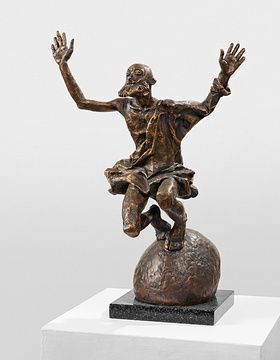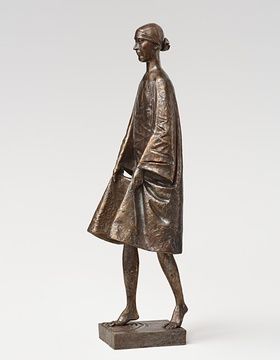Двадцать лет спустя
Двадцать лет спустя

Поступательное движение Дронова происходило сравнительно спокойно и плавно, не смотря на его явное пристрастие к иронии, гротеску и доброму юмору.
В отличие от Тугаринова, он менее склонен к содержательным и формальным авантюрам. Например, его «Мудрецы» (1998) и одна из последних работ «Болото» (2008) по своему композиционному строю сравнимы с роденовскими «Гражданами Кале», тем более что конкретной принадлежности к какой-то определенной эпохе в героях Дронова не обнаруживается. «Рыбак», «Старик с хворостом» или «Старый король» – это также общечеловеческие образы на все времена. А «Последний день Помпеи» (1998) и вовсе погружает зрителя в глубокую древность. Причем ни к каким особенным формальным ухищрениям скульптор не прибегает, изображая застывшие в бронзе складки одежды, объемлющие пустоту вместо человеческого тела, напоминая тем самым о трагедии, постигшей итальянский город, засыпанный вулканическим пеплом.
Несмотря на отмеченное содержательное пристрастие к вечным темам, Дронов остается нашим современником. Чтобы убедиться в этом, достаточно обратиться к его известной скульптуре, которая в старом каталоге называется «Зимние похороны», а в самом последнем, вышедшем к выставке в галерее «Дом Нащокина», – «Саксофонист». Сутулый пожилой мужичок в шапке-ушанке и валенках держит в руках музыкальный инструмент, который явно противоречит его простецкому виду.
Но именно этот контраст и есть сознательная затея скульптора, стремящегося передать драматизм, нелепость и будничность остановленного мгновения, увиденного в той самой нашей российской жизни, где «терзают Шопена лабухи» и никакой сюрреализм не кажется странным. Впрочем, такая прицельная конкретность в искусстве Дронова редкость. Ему ближе скупые пластические формулы, неизменно отличающиеся четкой ритмикой форм: «Робин Гуд», «Девочка на шаре», «Охотник», «Пионер», «Шарманщик», «Конькобежец»... При всей разности тем и образов в этих и близких им работах хорошо различима индивидуальная стилистика и острота наблюдения, а также редкое умение выявить точный жест. Ритмика «Ночных гостей» (1987), «Осьминога» (1993) и «Лебединого озера» (1994) и вовсе сродни черно-белой замедленной киносъемке, завораживающей зрителя.
На первый взгляд особняком смотрятся такие работы, как «Колбаса» (1997), «Гирьки» (1998), «Кораблик» (2000), «Скамейка», «Валенки» (обе 2001), «Кнопка» (2002). Но в принципе их появление вполне логично и дело не только в присущем Михаилу мягком юморе. Налицо любовь к ясно выраженной пластической форме, к лапидарному стилю. На последнем, кстати, Дронов чрезмерно не сосредотачивается, постоянно возвращаясь к тому, что принято считать скульптурной классикой.
В частности, «Святой Петр» (2001 год – первоначальный малый вариант и 2008 – большая фигура) – яркий пример подобного традиционного подхода. Мощная монументальная фигура сидящего апостола утяжелена крупными складками длиннополой одежды. Но для усугубления монументальности Дронов далеко не всегда прибегает к формальным утяжелениям и увеличению размера. Его миниатюрный «Гиппопотам» (2002), например, ничуть не уступает любым масштабным изваяниям разных лет. Причина этого в том, что у Дронова тяготение к монументальности связано не с размером вещей, а с внутренним ощущением монументального ритма. И есть еще одна любопытная «родовая» особенность, проявляющаяся в искусстве многих художников. Речь об автопортретности портретного жанра. «Святой Петр» – это, разумеется, не автопортрет, но, видимо, не только шутки ради Дронов сел и сфотографировался неподалеку от могучей фигуры апостола в той же позе.
Искусство Михаила Дронова производит впечатление основательности и спокойной уверенности, когда человек может сказать не только «я ищу», а «я нашел».
Аукцион искусства и старины art-picture.ru предоставляет возможность покупки
приобрести представленны лоты по теме "Двадцать лет спустя"









